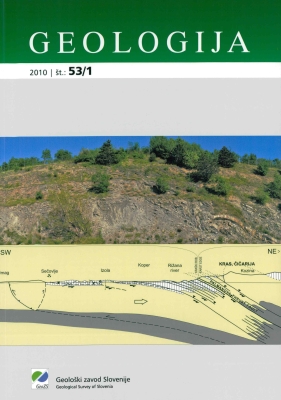The bases for understanding of the NW Dinarides and Istria Peninsula tectonics
DOI:
https://doi.org/10.5474/geologija.2010.005Abstract
Thrust structure of the northeastern part of the External Dinarides is depended upon paleogeography of the Adriatic-Dinaric Mesozoic Carbonate Platform, which was in the southeast (in the recent position) composed of Dinaric and Adriatic segment with intermediate Budva Trough. In the northwest in the area of the present Slovenia, it represents uniform platform. In the northwestern continuation of the Budva Trough, shallow halftrough formed and more to the west, shallow Friuli Paleogene Basin came in to being, which separated so called Friuli Carbonate Platform from the central part of the carbonate platform. Area of Istria was separated from Adriatic segment with Kvarner Fault, originated already in the Mesozoic. External Dinaric Thrust Belt formed in the final phase of the Dinarides overthrusting. It originated from Dinaric segment of the Mesozoic Carbonate Platform at the end of the Eocene and was thrusted on the Adriatic segment of the Mesozoic Carbonate Platform. Whole process also triggered formation of the External Dinaric Imbricate Belt with Thrust Front of the External Dinarides against Adriatic-Apulian Foreland. Later also represents rigid indenter of the Adria Lithospheric Microplate ("Adria"), and External Dinaric Imbricate Belt represents its deformed margin, therefore we place it to the rigid indenter. Segmentation of the "Adria" occurred in the Miocene or later. It roughly disintegrated in the Padan and Adriatic part along Kvarner Fault. During rotation of the Padan part in the counter clockwise sense, the corner part, representing Istria Peninsula, rotated and underthrusted towards northeast under External Dinarides. As a result, Istria- Friuli Underthrust Zone formed, structurally conditioned with the position of the Friuli Paleogene Basin, and vast Istria Pushed Area between Southern Alps, Velebit Mts. and Želimlje Fault. This process is still active recently. During Istria underthrusting and pushing in the northwest direction, Raša Fault and Thrust Front of the External Dinaric Thrust Belt bended, and as a consequence, strike-slip movements along those planes were hindered. From the tip of the Kvarner Bay towards Idrija and Ravne Faults in the Upper Soča Valley, conditions for formation of the en echalon strike-slip belt were set up. The strike-slip belt is defined with segment of the Raša Fault southeast from Ilirska Bistrica, seismically active area between Ilirska Bistrica - Hruševje stretch, Vipava Fault, Predjama Fault and northwestern part of the Idrija and Ravne Fault. Therefore we postulate, that a segment of the External Dinaric Thrust Belt Front and shear boundary between the tip of Kvarner Bay and Upper Soča Valley, with extended branches of the Idrija and Ravne Faults, represents new attached block of the Adria Microplate rigid indenter edge.Downloads
How to Cite
Placer, L., Vrabec, M., & Celarc, B. (2010). The bases for understanding of the NW Dinarides and Istria Peninsula tectonics. Geologija, 53(1), 55–86. https://doi.org/10.5474/geologija.2010.005
Issue
Section
Articles

